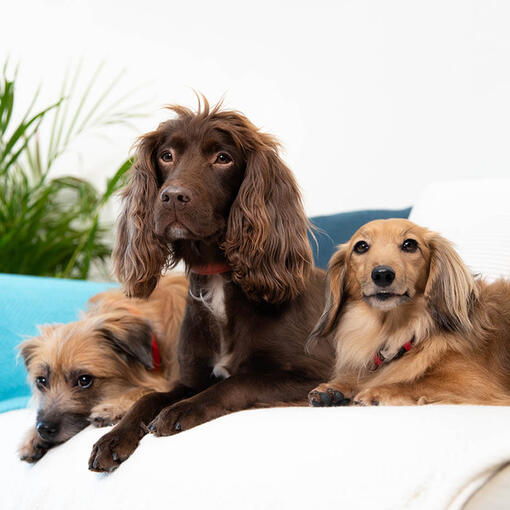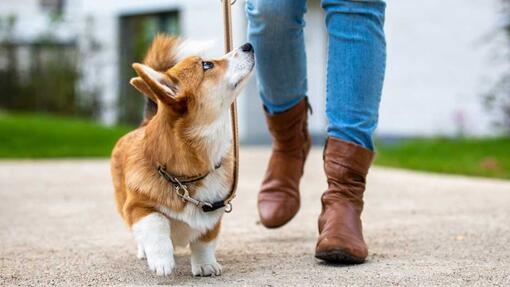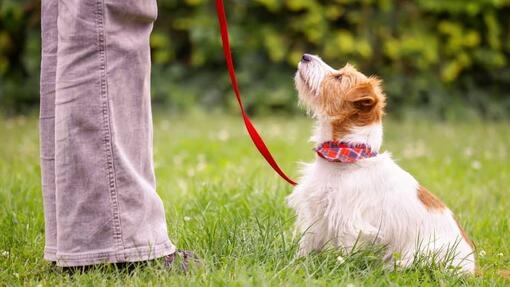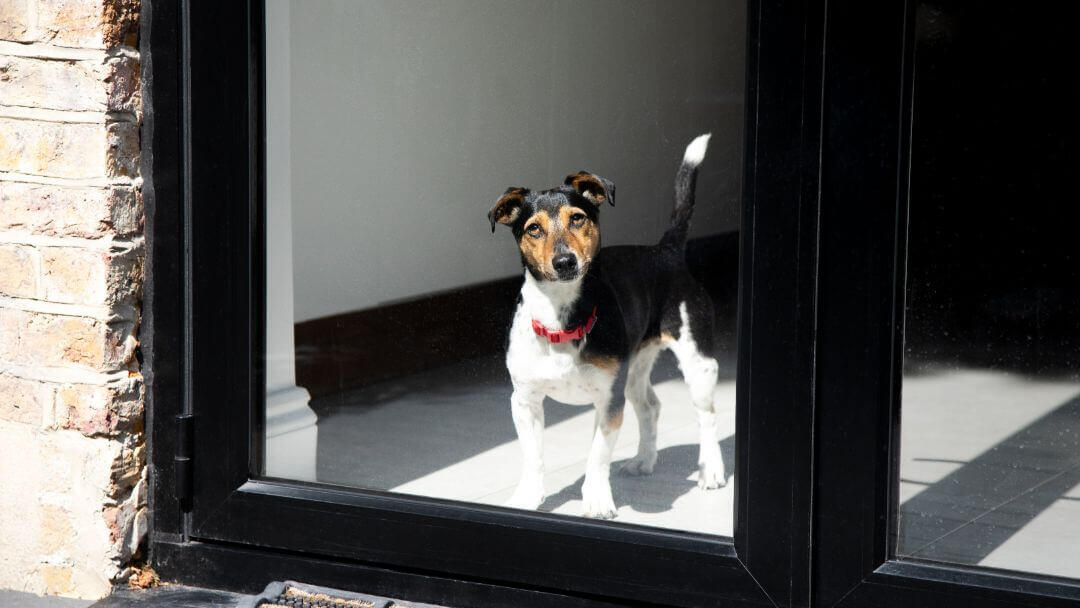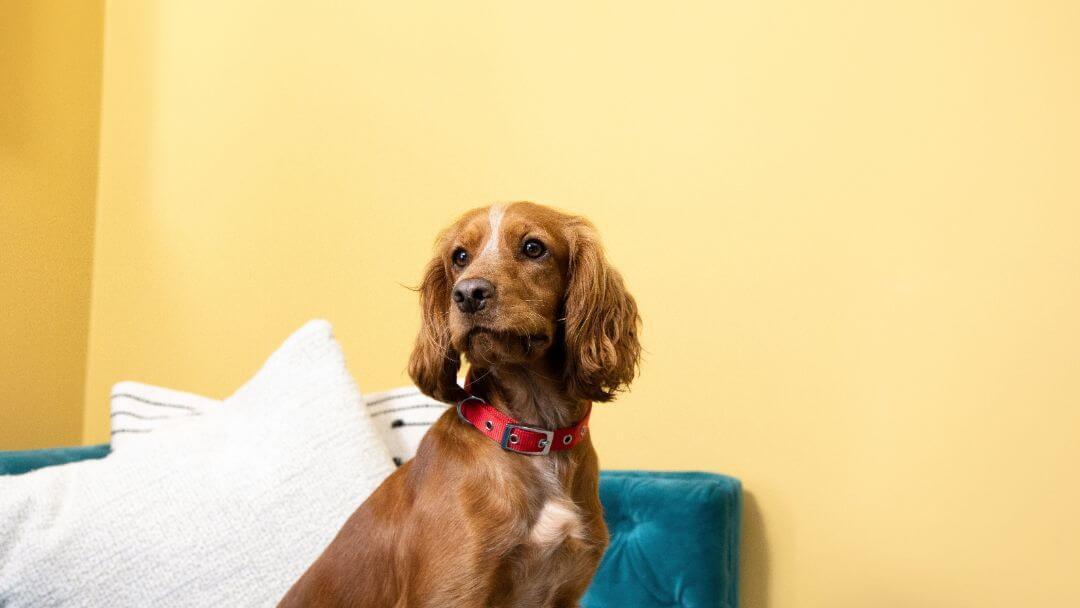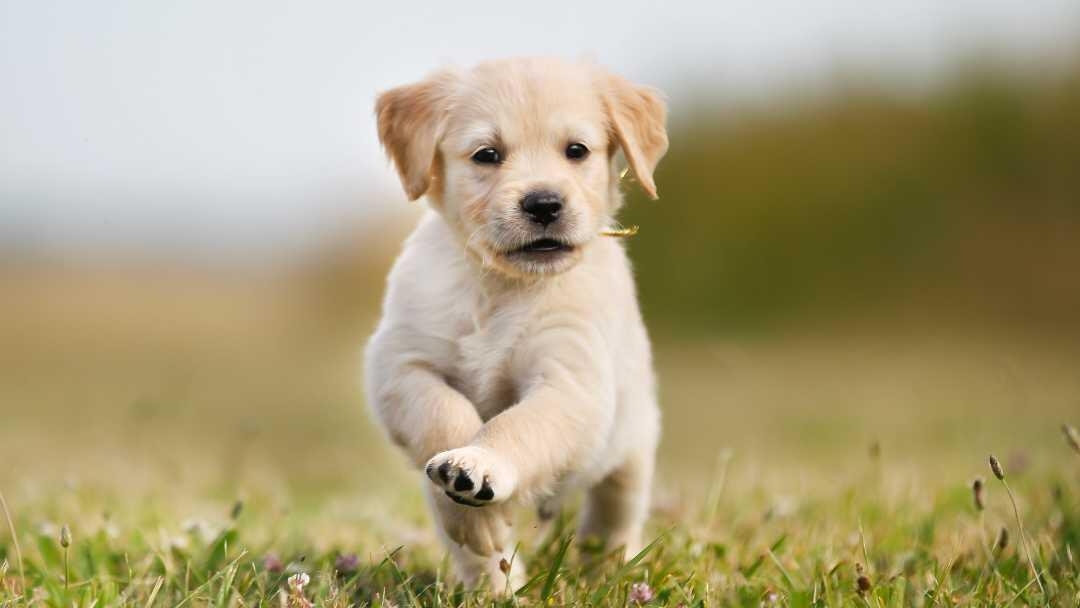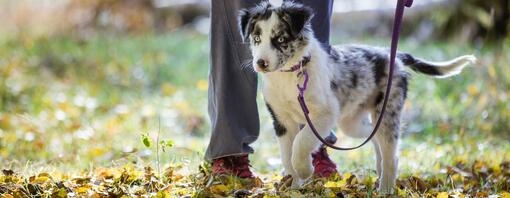
It’s the moment you've been waiting for. Your adorable puppy has now had their vaccinations, is fully protected, and is ready to venture out into the world. And of course, you are a responsible owner who knows dogs need a good walk or two every day so you can’t wait to get out there and show your puppy off to everyone you meet. But hang on a moment, there’s a few more things you need to consider here.
Your puppy is very young and even though you have been carrying them around, taking them to see the world in your arms, taking them out in the car for a drive, they still haven’t seen very much and they’re still tiny babies (no matter how big a breed you have!). So, see our guide on taking a puppy for their first walk – we have all the training tips you need, along with an equipment list!
When can puppies go for their first walk?
Your puppy can go on their first walk 1-2 weeks after their full vaccination – this is usually around 8 weeks. However, those long countryside walks will have to wait till about 4 months when they’re really ready to face the big wide world.
If your expectation for your first walk is that you’ll get them ready in harness and lead, head out the door, go to the park or off into the countryside, wander around having fun together, and then come home again, you might be surprised to find out that this isn’t always the case.
Why is taking a puppy for a first walk scary for them?
From your point of view, a trip to the park or round the block is no distance at all. It’s an easy walk, it will be fun to meet people and other dogs, and it’s necessary for your puppy’s education and growth. From your puppy’s point of view however, this is a bit like expecting a toddler to run a marathon!
Here’s why your pooch might be overwhelmed on their first puppy walk.
- Short legs mean it’s a much longer walk than you think it is
- When you are low to the ground, everything appears huge and intimidating – and don’t forget… it’s all new
- Overwhelming and totally new noises
- Overwhelming and totally new scents
- Overwhelming and totally new things to see
- They are constrained by the lead so they cannot choose where to go
- Expected to walk for a long time without a break at someone else’s pace which is far more tiring than stopping and starting at their own pace
- Unfamiliar surfaces and textures under their paws (tarmac, concrete, flagstones)
- Limited ability to communicate with you due to their age
- Limited ability to concentrate for the duration of the walk – all this novelty takes brain power
- And lack of training and puppy experience on how to walk on the lead. You can see our guide for help on this!
It’s easy to see how the walk you think will be fun, could be an epic test of endurance both mentally and physically for your puppy!
Equipment list for puppy’s first walks
Before you head off out into the great outdoors with your puppy, there’s some shopping you need to do in order to have all the things needed to ensure their future and first puppy walks are happy, comfortable, and safe. Here’s what you need:
Lightweight lead
This should be a soft training lead around 2m length as this will be long enough to practice training exercises (including recall) within the length of the lead, whilst still being easy to shorten when necessary. Make sure the weight of the lead and the clip are not too heavy or oversized for your puppy.
Securely fitting harness
There are a lot of harnesses about, however not all of them are good and of the good ones, not all will fit your puppy correctly. Harnesses should be of the stretchy vest type, or the Y front chest piece type, as these allow free movement of the shoulders and are reasonably secure (though any harness without a second girth strap can be backed out of by a very determined puppy, so if your puppy goes backwards fast, go with them don’t pull back on the lead!).
Avoid harnesses that use sliding straps that tighten up to discourage pulling and avoid any with a horizontal chest piece as these affect the movement of the shoulder joint which is obviously bad for a growing puppy.
Harnesses of the strap type should fit without being too close to your puppy’s armpit/elbow, and should fit snug around the ribcage, not sitting on the floating ribs right at the back, and not impeding breathing.
In a growing puppy you should check harness fit every few days as a harness that is too tight or pinches will really put your puppy off wearing it or even off walkies altogether!
Treat pouch
You can buy any number of these, or line an easy access coat pocket with a plastic bag. The main point is that you can easily grab a treat to reward something your puppy has done – even if unexpected - and are not fumbling around for ages. Your puppy has a short attention span and even with a marker such as a clicker or the word ‘yes’, will rapidly lose the connection between action and reward if you take too long to dig out a treat.
Suitable treats to reinforce behaviour
Dog treats for your puppy must be very small, very tasty, ideally soft or break down quickly – if your puppy is chewing away at a huge or hard treat, again there’s a good chance they’ve forgotten why they got it!
Treats can be delivered in a variety of ways too – you can give them from your fingers, though this may result in nipped fingers or a small puppy being encouraged to jump up to reach (or a bad back from constantly leaning down to give the treat), but you can also throw treats ahead or behind you, or drop treats, and you can offer a tube of cheese spread or doggy pate for your dog to lick direct from the tube. Try things out and see what works for you, and of course… your puppy has to really like the treats to start with!
Poo bags
These should be self-explanatory – always pick up poo!
Kitchen roll
It is not unusual that an excited, cheese filled puppy will do a soft, loose poo, and it always seems to be that poo will be right in someone’s gateway or the middle of the path, so a few squares of kitchen roll will make that mess much easier to clear up.
Bottle of water
This is for offering your puppy a drink but also can help with the aforementioned poo! A little rinse down after you’ve cleaned up with kitchen roll will help matters no end and avoid any irate neighbours.
Fold flat water dish
These are great and totally portable. Keep one in your bag, car, pocket… so much more convenient than trying to get your puppy to drink the dribble of water poured out of a water bottle. If you’re using lots of food rewards (and you should be) then your puppy may well need a drink - and it is hard to concentrate and learn if you’re thirsty.
Your vets’ number in your phone
There is no panic quite like being in the park with a puppy bleeding profusely from a cut pad, or some other veterinary drama, and realising you have no internet signal and don’t know the vets phone number!
With just these few items, you are ready to take on the world with your puppy! So, get out there and start having fun!
How to train your pup on their first puppy walks
Aim to pair all the sights, sounds, smells and movements with tasty treats to build positive associations, and you will find that before long you can build up to real walks as your puppy gets more confident.
Here's an example session for a 10 week old puppy who might not be very brave (but every session depends on where you go and what you encounter):
- Mark (say ‘good’ or ‘yay’ or similar) and treat for looking at owner as they step out the door
- Mark and treat for car door slam
- Mark and treat for a bird flying out of hedge
- Encourage investigating a good sniff
- Mark and treat when they stop sniffing (on their own – not you pulling them away!)
- Mark and treat for person walking past the gate
- Mark and treat for looking at you (every time)
- Mark and treat for following you two steps forward
- Mark and treat for following you two steps to the left
- *Puppy starts to look full or bored* End session.
- Puppy still enthusiastic – repeat as above for five more minutes. End session
By following this protocol, you’ll find it very easy to tell which things worry your puppy, which things your puppy is brave and confident about, how quickly your puppy learns, and how focused on you they are. All that information helps you in the future as you increase session times and increase the distance you go from home. You’ll have a drama and disaster proofed puppy, and can avoid being the person whose puppy won’t move, bites the lead, yells at passing dogs and cats, or drags their owner everywhere!
Top tips for training your puppy on their first walk
- Limit these sessions in terms of time and/or number of food reinforcers given, but be sure to end before your puppy has had enough.
- So, you may set out to hang around in your front garden, or on the pavement outside your front door for a maximum of 5 minutes or 20 rewards, whichever is achieved first – but if your puppy looks like they may be about to say it’s too much at 3 minutes or 12 rewards, you’d stop there and go back inside.
- Start to aim for 5 minutes - it is easy to add more on if your puppy is very brave and curious to explore, but remember the further you get from home, the longer it is going to take to get back home, which you need to do before your puppy has had enough, is tired, or cannot concentrate. In general, for specifically on-lead puppy exercise for the average puppy of 12 weeks, 15 minutes is the maximum you’d push for in one go, but in reality that would be far too much for some, and not quite enough for others. So, starting out slow and seeing what your puppy tells you is the safest way forward.
- When your pup is ready to explore a bit further, start off without having any set route in mind, forget about reaching a particular destination and don't have any fixed ideas on how long you will be out.
The secret of success is to be really mindful of what is going on around you and rewarding your puppy for every new experience – whether sight, sound, or smell. And be patient. Let your puppy experience each new thing in their own time. Remember that dogs learn about their environment through scent often more than they do by sight or sound – so let your puppy sniff as much as they want to (even if you think it is pretty boring). They are learning with each sniff. Always reward them when they stop sniffing and look back at you or continue the walk.
How often should I train my puppy on their first walks?
You can do as many of these sessions in a day as your puppy has time for between sleeps, playing, snuggling and indoor training. Keep an eye on their dog body language during these sessions to gauge their behaviour in response to the training.
Which food rewards should I give my puppy on their first walks?
Your food rewards or treats should be really tiny, and easy to eat – hot dog sausage cut into 30 pieces, cubes of cheddar half the size of your pinkie fingernail, single licks of a tube of cheese spread etc.
What do I do if my puppy wants to explore further on their first walks?
If your puppy is braver than expected and wants to go further, you can do this, just stay within ‘quickly scooping puppy up and getting inside’ distance, so if something truly scary moves into view (big clanking trailer turns into your street, person with enormous trio of barking dogs starts to approach) you can get to safety rather than have your puppy face a scary incident.
There is no value in over-facing your puppy and putting them through an experience that frightens them!
If you want to go further afield than your front door/street, or if you suspect the street outside your front door is too much to begin with, then you can drive somewhere that allows you to park somewhere safe, and practice just outside your car, with the car being the ‘safe zone’ you can get back inside should anything overwhelming occur.
You may find using a back door/back gate is a better option in some cases, if you have a quiet backstreet and a busy street out front.
Some puppies are brave up to a point and then jam on the brakes – this is completely normal and again we can avoid them doing that by doing lots of little sessions, venturing further every few days, rather than diving in with longer walks. If this does happen though, stop, wait for your puppy to assess whatever is going on, and once they’re happy you can go home – carry them if necessary. It wouldn’t be wise to continue once your puppy has already indicated that they’re overwhelmed, as while they may find a second wind, they’re also less likely to cope with whatever happens next.
Benefits of taking the first puppy walk slow
Although this may seem boring, or overly cautious, remember that a single scary event (even if the puppy wasn’t physically harmed in anyway, simply being terrified *is* the scary thing) can leave a huge impression and take an enormous number of positive, rewarding experiences to overcome – and sometimes is never entirely forgotten.
Here are some of the benefits of approaching a puppy’s first walks this way:
- Avoid reactivity to sounds/sights
- Builds positive experiences of the new sounds/sights/surface textures by avoiding scary experiences
- Avoid pulling on the lead as it is easy to practice loose lead walking
- Encourage listening to you and putting attention/focus on you
- Build a solid expectation that trips outdoors are safe and fun
- Build a solid association between being outdoors and listening to you
- Avoid scary experiences that have long lasting consequences
- Proof your earlier indoor training outdoors.
- Success breeds success – by having multiple short sessions, if one goes wrong, you have many more sessions that will go as planned. If you have only two walks and something goes badly wrong on one of them, that’s only 50% success. If you do ten mini sessions and one goes wrong, that’s 90% success!
This approach to introducing your puppy to the idea of walks also fits in very nicely with the training you have yet to do, proofing your puppy to walking on a loose lead, teaching them that sit, down, stay (on the lead), come (on the lead) all mean the same things out here, in the world, as they do indoors. All these things require short exposure, the ability to avoid unwanted behaviours, lots of repetition and practice.
How to avoid disaster on puppy’s first walks
If you have gone too far from home or you have no choice but to start off in a busy place or park, here’s a few tips to avoid disaster.
Pick your puppy up if you need to.
Big dogs approaching, busy streets full of pedestrians, these do pose a risk to small dogs no matter how friendly and well meaning. Yes, this may encourage a loose dog to jump up at you, but better that than your small puppy being squished, trampled or traumatised.
Take evasive action.
If you can’t pick your puppy up, and something is approaching you don’t like the look of, your puppy is worried about, or you simply don’t think your puppy is ready for, simply turn around, go the other way, cross the road, and get your puppy out of the way and out of eye-line of whatever it is.
Avoid meeting other dogs at first
It’s not a good idea to let your puppy meet every dog you see – as they need to learn to pay attention to you around other dogs rather than expect to interact with them. If you can speak to the owner first and if your assessment of the situation is that their dog seems under control, steady, and very calm, then you can allow them to meet. Keep meetings very brief, keep your body language and voice light and happy, and keep the lead loose wherever possible. Call away to end the greeting after about 20 seconds in a happy tone, and reward your puppy well for coming away with you. If at all possible, instead of meeting head on, see if you can follow along behind for a little while then catch up and walk side by side before any sniffing and greeting happens. This allows your puppy chance to pick up lots of scent and chill a bit before saying hello.
We hope this article on first puppy walks was helpful! Next, see our guides on how long you should walk your dog and all about dog walking etiquette.

